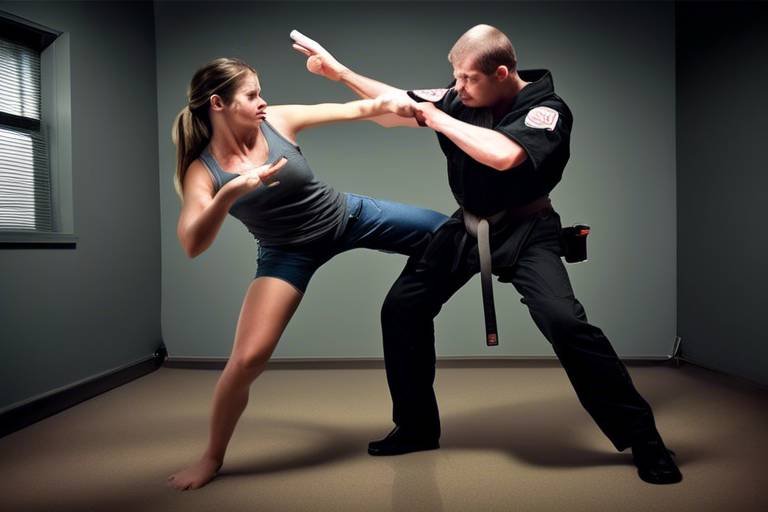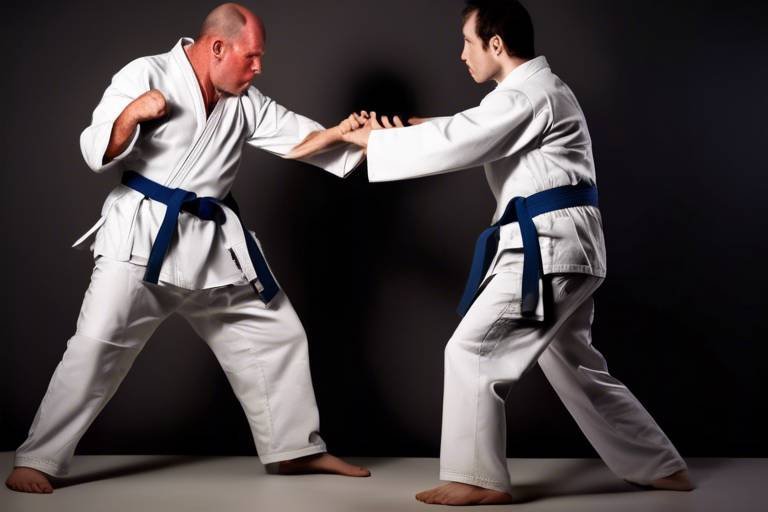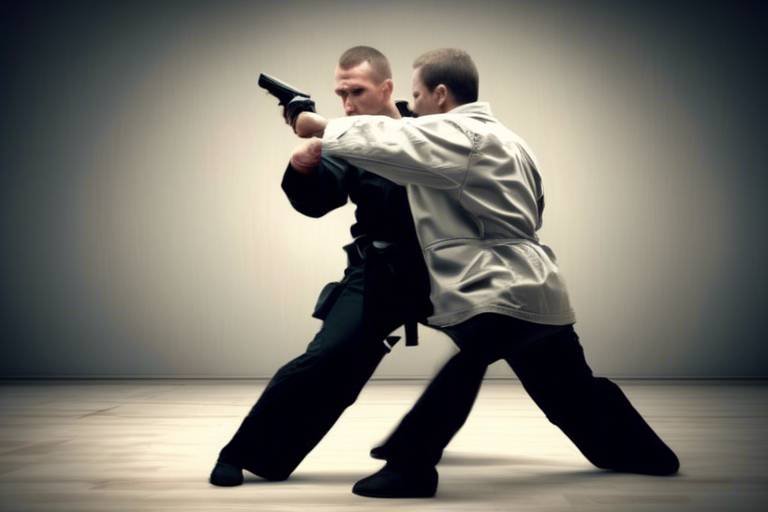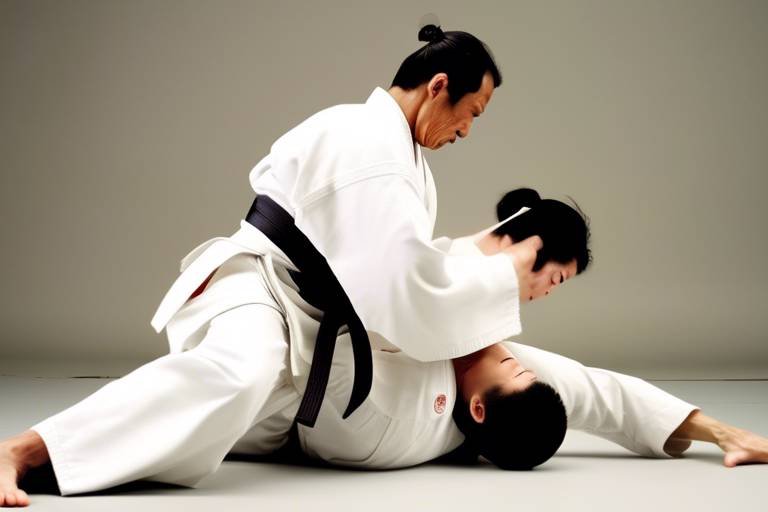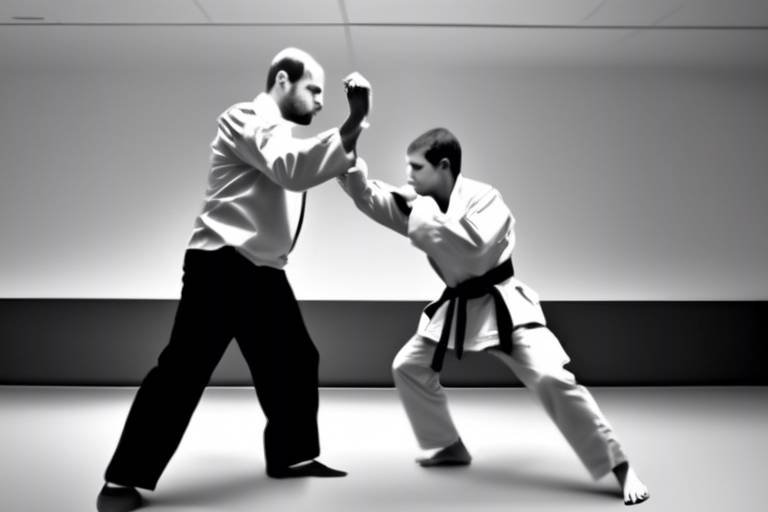How to Maintain Motivation While Training in Self-Defense Techniques?
Training in self-defense techniques can be an incredibly empowering journey. However, like any endeavor, it’s easy to lose motivation along the way. Have you ever found yourself dreading your training sessions or feeling like you're just going through the motions? You're not alone! The key to maintaining that fiery passion for self-defense lies in understanding a few fundamental strategies that can keep you engaged, excited, and eager to hit the mats. In this article, we’ll explore various tips and techniques designed to enhance your training experience and help you achieve your goals effectively.
When it comes to self-defense training, one of the most effective ways to boost your motivation is by establishing clear goals. Think of your goals as the North Star guiding your journey. By setting specific, measurable, achievable, relevant, and time-bound (SMART) objectives, you can create a roadmap for your training. For instance, instead of saying, “I want to get better at self-defense,” try something more concrete like, “I want to learn three new techniques in the next month.” This clarity helps you stay focused, track your progress, and celebrate your achievements along the way.
Another essential element for maintaining motivation is developing a consistent training schedule. Imagine trying to build a house without a blueprint—chaotic, right? The same goes for your training. By allocating specific times for practice, you can cultivate a routine that fosters discipline and commitment. Whether you prefer early morning sessions or evening classes, find a schedule that works for you and stick to it. Over time, this routine will become second nature, and you'll find yourself looking forward to each session.
Let’s face it: doing the same thing day in and day out can become monotonous. To keep your motivation levels high, it’s crucial to introduce a mix of techniques and styles in your training. Exploring different self-defense methods not only prevents boredom but also enhances your skill set. For example, you might alternate between Brazilian Jiu-Jitsu, Krav Maga, or Muay Thai. This variety keeps the experience fresh and exciting, ensuring that you remain engaged and motivated to practice regularly.
Training with a partner can be a game-changer in your self-defense journey. Not only does it provide mutual support and encouragement, but it also transforms your sessions into a fun and interactive experience. Think of your training partner as your accountability buddy; you motivate each other to push through tough drills and celebrate each other's successes. Plus, working together allows you to learn from one another, making the training process even more rewarding.
While partner training is fantastic, solo drills also play a vital role in refining your skills. These practice sessions allow you to focus on your individual needs and work on specific techniques at your own pace. Whether it’s shadow boxing, practicing stances, or working on footwork, solo drills can be tailored to target areas where you want to improve. This personalized approach ensures continuous growth and keeps your motivation levels high.
Keeping a journal or log of your training sessions is another powerful tool for maintaining motivation. By documenting your achievements, challenges, and improvements, you can visualize your progress over time. Consider it a personal highlight reel of your journey. When you look back and see how far you’ve come, it can provide a significant boost of motivation. You might even want to set aside time each week to review your log and reflect on your growth.
Joining a self-defense class or community can significantly enhance your motivation through shared experiences. Engaging with like-minded individuals fosters camaraderie and encourages you to stay committed to your training. You’ll find that the energy of a supportive community can be contagious, inspiring you to push through tough days when your motivation wanes.
In today’s digital age, participating in online forums or social media groups dedicated to self-defense can provide valuable resources and motivation. These platforms are filled with individuals who share their experiences, tips, and encouragement. Engaging in discussions can inspire you to stay dedicated to your training and even introduce you to new techniques or training methods that you hadn’t considered before.
Attending local self-defense classes or events can deepen your connection to the practice. Meeting new people and participating in workshops can reignite your passion and motivation for training. Plus, you might discover new friends who share your interests and goals, making your training journey even more enjoyable.
- How often should I train in self-defense? Aim for at least 2-3 times a week to see consistent progress.
- What if I feel unmotivated to train? Revisit your goals, change up your routine, or find a training partner to reignite your passion.
- Can I train alone effectively? Absolutely! Incorporate solo drills and focus on areas you want to improve.

Setting Clear Goals
This article explores various strategies to keep your motivation high during self-defense training. Discover tips, techniques, and insights to enhance your training experience and achieve your goals effectively.
Establishing specific, measurable, achievable, relevant, and time-bound (SMART) goals can significantly enhance your motivation. When you set clear objectives, you're not just wandering aimlessly through your training; you're creating a roadmap to success. Imagine you're on a road trip without a destination—how would you know when you’ve arrived? Setting goals is like putting a pin on the map; it gives you direction and something to strive for.
To effectively set your goals, consider the following elements:
- Specific: Define exactly what you want to achieve. Instead of saying, "I want to get better at self-defense," specify, "I want to learn three new techniques by the end of the month."
- Measurable: Make sure you can track your progress. This could mean keeping a log of your training sessions or noting down the techniques you’ve mastered.
- Achievable: Your goals should be realistic. If you're a beginner, aiming to become a black belt in a month might be a bit too ambitious!
- Relevant: Ensure your goals align with your overall motivation for training. If your goal is to feel safer in everyday life, your training should reflect that.
- Time-bound: Set a deadline for your goals. This creates a sense of urgency and helps you stay focused.
Once you've established your SMART goals, it's crucial to revisit and adjust them as needed. Life can throw curveballs, and sometimes, your initial goals may need a little tweaking. Regularly reviewing your objectives not only keeps them fresh in your mind but also allows you to celebrate small victories along the way. Remember, every step forward is progress, no matter how small!
Incorporating these goal-setting techniques into your self-defense training can be a game-changer. You'll find that having clear goals not only enhances your motivation but also makes your training sessions more purposeful and fulfilling. So, grab a pen and paper, or open your favorite note-taking app, and start mapping out your self-defense journey today!
A consistent training schedule is essential for maintaining motivation. By allocating specific times for practice, you can build a routine that fosters discipline and commitment to your self-defense training.
Introducing a mix of techniques and styles in your training can prevent boredom. Exploring different self-defense methods keeps the experience fresh and exciting, enhancing your motivation to practice regularly.
Training with a partner can provide mutual support and encouragement. Working together not only makes sessions more enjoyable but also helps you stay accountable and motivated in your self-defense practice.
Incorporating solo drills into your routine allows for individual focus and skill refinement. These practice sessions can be tailored to your specific needs, ensuring continuous improvement and motivation.
Keeping a journal or log of your training sessions allows you to visualize your progress. Documenting achievements, challenges, and improvements can boost motivation and provide a sense of accomplishment.
Joining a self-defense class or community can enhance motivation through shared experiences. Engaging with like-minded individuals fosters camaraderie and encourages you to stay committed to your training.
Participating in online forums or social media groups dedicated to self-defense can provide valuable resources and motivation. Sharing experiences and tips with others can inspire you to stay dedicated to your training.
Attending local self-defense classes or events can deepen your connection to the practice. Meeting new people and participating in workshops can reignite your passion and motivation for training.
Q: How do I know if my goals are realistic?
A: Assess your current skill level and resources. It’s helpful to set incremental goals that lead to larger objectives.
Q: What if I lose motivation during my training?
A: Revisit your goals, incorporate new techniques, or find a training partner to reignite your passion.
Q: How often should I review my goals?
A: It's beneficial to review your goals at least once a month to track your progress and make necessary adjustments.

Creating a Training Schedule
When it comes to self-defense training, consistency is key. Imagine trying to bake a cake by only mixing the ingredients once a month—chances are, you won't get the desired result. Similarly, establishing a training schedule is crucial for building your skills and maintaining your motivation. By setting aside specific times for practice, you create a routine that not only helps you stay disciplined but also fosters a sense of commitment to your self-defense journey.
To start, consider the following steps to create an effective training schedule:
- Assess Your Availability: Look at your weekly commitments and identify blocks of time you can dedicate to training. Whether it’s early mornings, lunch breaks, or evenings, find what works best for you.
- Set a Frequency: Decide how often you want to train each week. This could range from two to five times, depending on your goals and availability. Remember, quality over quantity is essential.
- Mix It Up: Incorporate different types of training sessions—some days can focus on technique drills, while others might emphasize sparring or fitness. This variety keeps things interesting and helps you develop a well-rounded skill set.
Here’s a simple example of what a weekly training schedule might look like:
| Day | Training Focus | Duration |
|---|---|---|
| Monday | Technique Drills | 1 hour |
| Wednesday | Sparring Practice | 1.5 hours |
| Friday | Fitness and Conditioning | 1 hour |
| Saturday | Solo Drills | 1 hour |
By sticking to a training schedule like this, you’ll not only see improvement over time but also cultivate a routine that becomes second nature. Think of it as laying the foundation for a house; without a solid base, everything else could crumble. So, take the time to create a schedule that fits your lifestyle and stick to it. Remember, the more you practice, the more confident you'll feel, and that confidence is what will keep you motivated.
Lastly, don’t forget to be flexible. Life can throw curveballs, and sometimes you might need to adjust your schedule. The key is to remain adaptable while keeping your eye on the prize—your self-defense goals. Embrace the journey, and soon enough, you'll find that training becomes not just a task, but a rewarding part of your life.

Incorporating Variety
When it comes to self-defense training, monotony can be your worst enemy. Imagine trying to learn how to defend yourself by repeating the same moves over and over again—sounds tedious, right? To keep your motivation soaring, it's essential to incorporate variety into your training routine. By mixing up techniques, styles, and even training environments, you can turn a mundane experience into an exhilarating journey of self-discovery and empowerment.
Think about it: just like a chef who spices up their dishes with different ingredients, you can enhance your training sessions by exploring various self-defense disciplines. Whether it’s Brazilian Jiu-Jitsu, Krav Maga, Muay Thai, or even traditional martial arts like Karate or Taekwondo, each style offers unique techniques and philosophies. This diversity not only keeps your training interesting but also equips you with a broader skill set that can be invaluable in real-life situations.
Moreover, you can introduce different training methods to keep things fresh. For instance, consider alternating between:
- Shadowboxing: This allows you to practice techniques without a partner, focusing on form and footwork.
- Pad Work: Using focus mitts or kick pads with a partner can enhance your striking skills while providing immediate feedback.
- Scenario Training: Simulating real-life situations can help you apply techniques under pressure and improve your reaction time.
- Fitness Training: Incorporating strength and conditioning exercises can boost your overall fitness, making you a more effective self-defender.
Additionally, consider changing your training environment. If you usually train indoors, why not take your practice outside? The fresh air and natural surroundings can invigorate your sessions and provide a new perspective on your techniques. Plus, training outdoors can simulate real-life scenarios better than a gym setting.
In essence, variety is not just the spice of life; it's the secret sauce to keeping your self-defense training engaging and motivating. By embracing a mix of techniques, styles, and environments, you can create a dynamic training experience that not only enhances your skills but also fuels your passion for self-defense.
Q: Why is variety important in self-defense training?
A: Variety prevents boredom, keeps you engaged, and helps you develop a broader skill set. It also allows you to adapt to different situations and challenges.
Q: How often should I change my training routine?
A: It's beneficial to change your routine every few weeks or whenever you start to feel bored. This could include trying new techniques, changing your training environment, or incorporating different training methods.
Q: Can I practice self-defense techniques on my own?
A: Absolutely! Solo drills are a great way to refine your skills. You can practice shadowboxing, footwork, and even visualization techniques to enhance your self-defense abilities.
Q: Should I focus on one self-defense style or learn multiple?
A: While specializing in one style can be beneficial, learning multiple styles can provide you with a diverse skill set and better prepare you for various situations.

Partner Training
Training with a partner can be one of the most rewarding aspects of self-defense practice. Imagine stepping onto the mat, knowing that someone else is there to share the journey with you. It’s like having a workout buddy who not only keeps you accountable but also pushes you to improve. When you train with a partner, you create a dynamic environment where both of you can learn from each other’s strengths and weaknesses. This collaborative approach can enhance your skills significantly.
One of the key benefits of partner training is the element of mutual support. When you’re feeling a bit sluggish or unmotivated, your partner can provide that extra push you need. It’s like having a cheerleader right there with you! You can encourage each other through difficult drills, celebrate small victories, and even share tips on technique. This camaraderie not only makes the training sessions more enjoyable but also fosters a sense of community.
Moreover, practicing with a partner allows for more realistic scenarios. Self-defense is not just about techniques; it’s also about timing, distance, and reaction. By working together, you can simulate real-life situations, which helps you understand how to apply what you've learned under pressure. For instance, you might practice techniques such as:
- Blocking and countering attacks
- Escaping holds or grabs
- Executing joint locks or throws
These practical exercises are essential for building confidence and preparing you for actual self-defense situations. Plus, they can be a lot of fun! You can mix it up with friendly competitions or challenges, making each session feel fresh and exciting.
To get the most out of your partner training, consider setting some goals together. Whether it’s mastering a specific technique or increasing the intensity of your drills, having shared objectives can keep both of you motivated. You might even create a training plan that outlines what techniques to focus on each week. This way, you’ll have a structured approach to your practice that allows for continuous improvement.
In summary, partner training is not just an option; it’s a powerful tool in your self-defense arsenal. The blend of support, accountability, and real-world practice makes it an invaluable part of your training routine. So, grab a partner and start exploring the many ways you can grow together in your self-defense journey!
Q: What if I don’t have a training partner?
A: Don’t worry! You can still practice solo drills and techniques. Many self-defense skills can be refined alone, and you can also join local classes or online communities to find training partners.
Q: How often should I train with a partner?
A: Aim for at least once or twice a week if possible. Consistency is key, and regular practice with a partner will help reinforce what you've learned.
Q: Can I train with someone who is less experienced?
A: Absolutely! Training with someone less experienced can be beneficial for both of you. You can teach them what you know while also reinforcing your own skills.

Solo Drills
When it comes to self-defense training, are your secret weapon. They allow you to practice techniques at your own pace, without the pressure of a partner watching your every move. Think of solo drills as your personal playground where you can experiment, refine, and master your skills. It’s like being an artist with a blank canvas; you have the freedom to create your own masterpiece!
One of the biggest advantages of solo drills is the ability to focus on specific techniques that may need extra attention. For instance, if you’re struggling with a particular punch or kick, you can dedicate an entire session to perfecting that move. This focused practice helps to build muscle memory, making those movements second nature when it counts the most. Plus, you can tailor your drills to suit your individual needs, ensuring that every minute spent training is productive.
To make the most out of your solo training sessions, consider the following tips:
- Warm-Up: Always start with a proper warm-up to prevent injuries. A few minutes of stretching or light cardio can make a world of difference.
- Set a Routine: Create a structured routine for your drills. This could involve alternating between striking, blocking, and footwork drills, giving your training a well-rounded approach.
- Use Visual Aids: Consider using mirrors or recording your sessions. Watching yourself can help identify areas for improvement and enhance your technique.
- Challenge Yourself: Push your limits by increasing the speed or intensity of your drills. Just like lifting weights, the more you challenge yourself, the more you grow!
Solo drills don’t have to be monotonous either. You can mix things up by incorporating different environments or using props. For example, practicing outside can add a new dimension to your training, or using a punching bag can help simulate a real opponent. The key is to keep things exciting and engaging, so you look forward to each session.
In conclusion, solo drills are not just about repetition; they are about growth and self-discovery. By dedicating time to these individual practices, you are not only enhancing your self-defense skills but also building confidence in your abilities. So, the next time you hit the mat alone, remember: you’re not just training; you’re crafting your own path to mastery!
Q: How often should I do solo drills?
A: Aim for at least 2-3 times a week, but feel free to adjust based on your schedule and goals. Consistency is key!
Q: Can I practice self-defense techniques at home?
A: Absolutely! Just ensure you have enough space and a safe environment to practice your moves.
Q: What if I don't have any equipment?
A: Many self-defense techniques can be practiced without equipment. Focus on footwork, body mechanics, and shadow techniques to get started.
Q: How can I stay motivated during solo training?
A: Set personal goals, track your progress, and mix up your drills to keep things fresh and exciting!

Tracking Progress
Tracking your progress in self-defense training is akin to keeping a scorecard in a game; it not only provides you with insight into how far you've come but also fuels your motivation to keep pushing forward. Imagine stepping into a dojo or training space, and instead of just going through the motions, you have a clear understanding of your achievements and areas for improvement. This clarity can be incredibly motivating!
One effective way to track your progress is by maintaining a training journal. In this journal, you can document various aspects of your training sessions, such as:
- Date and time of each session
- Techniques practiced, including any new skills learned
- Duration of the training session
- Personal reflections on what went well and what could be improved
By regularly writing in your journal, you create a tangible record of your journey. You’ll be amazed at how motivating it is to flip back through the pages and see your progress over time. It's like looking at a time-lapse video of your growth—each entry a snapshot of your dedication and hard work.
Another method to visualize your progress is through the use of charts or tables. For instance, you could create a simple table that tracks the number of techniques you’ve mastered over time. Here’s an example:
| Date | Technique Learned | Mastery Level (1-5) |
|---|---|---|
| 01/01/2023 | Basic Jab | 4 |
| 01/15/2023 | Roundhouse Kick | 3 |
| 02/01/2023 | Self-Defense Against Grabs | 5 |
This visual representation not only highlights your achievements but also serves as a reminder of the techniques you’re still working on. It’s a great way to keep the fire of motivation burning bright!
Lastly, consider sharing your progress with a training partner or instructor. They can provide valuable feedback and encouragement, which can further enhance your motivation. Remember, progress is not just about the end goal; it's about enjoying the journey and celebrating the small victories along the way!
Q: How often should I track my progress?
A: Ideally, you should track your progress after every training session. This allows you to capture immediate thoughts and feelings about your performance, making your reflections more accurate and meaningful.
Q: What should I do if I feel like I'm not making progress?
A: It's normal to hit plateaus in training. Revisit your goals, adjust your training methods, or seek feedback from instructors or peers. Remember, progress isn't always linear!
Q: Can I use apps to track my progress?
A: Absolutely! There are many fitness and training apps available that can help you log your sessions, track techniques, and visualize your progress through graphs and charts.

Finding a Supportive Community
When it comes to self-defense training, one of the most powerful motivators can be the community you surround yourself with. Imagine stepping into a room filled with individuals who share the same passion for self-defense as you do. The energy is palpable, and suddenly, the challenges you face seem a little less daunting. This is the magic of finding a supportive community. Not only does it provide a sense of belonging, but it also fosters an environment where you can thrive and grow in your training.
Engaging with a community of like-minded individuals can significantly enhance your motivation. You’ll find that sharing experiences, challenges, and triumphs with others can be incredibly uplifting. Think of it as a team sport—when everyone is cheering each other on, it’s easier to push through those tough training days. Whether it’s a local class, an online forum, or a social media group, being part of a community can keep you inspired and accountable. You might even discover new techniques or training methods that you hadn’t considered before!
Furthermore, joining a self-defense class or community can lead to lasting friendships. These connections can provide not just motivation but also a support system that extends beyond the training mat. You’ll have buddies to practice with, share tips, and even attend events together. The camaraderie that develops can make training feel less like a chore and more like a fun activity. Plus, there’s nothing quite like the satisfaction of celebrating each other’s progress and achievements.
Here are some avenues to explore when looking for your supportive community:
- Online Forums and Groups: Websites and social media platforms often host groups dedicated to self-defense. These can be great places to ask questions, share insights, and find inspiration from others who are on a similar journey.
- Local Classes and Events: Check out local self-defense classes or workshops in your area. These events are not only educational but also provide opportunities to meet people who share your interests.
- Workshops and Seminars: Participating in specialized workshops can deepen your understanding and connect you with experts and enthusiasts alike.
In summary, finding a supportive community can be a game-changer in your self-defense training journey. It’s not just about learning techniques; it’s about building relationships that inspire you to keep pushing forward. So, don’t hesitate to seek out those connections. Whether online or in-person, the right community can transform your training experience from solitary practice to a vibrant, collaborative endeavor.
Q: How can I find a local self-defense class?
A: You can search online for self-defense classes in your area, check community centers, or look for local martial arts studios that offer self-defense training.
Q: What are the benefits of joining a self-defense community?
A: Joining a community provides motivation, accountability, and valuable connections. It also offers opportunities to learn from others and share experiences, making your training more enjoyable.
Q: Can I participate in self-defense training online?
A: Absolutely! Many online platforms offer self-defense courses and forums where you can connect with others. This can be a great option if you prefer training from home or if local options are limited.
Q: How do I stay motivated if I can't find a community?
A: If you can’t find a community, consider creating one! Reach out to friends or family interested in self-defense, or participate in online forums to connect with others. Keeping a training journal can also help maintain your motivation.

Online Forums and Groups
In today's digital age, connecting with others who share your passion for self-defense has never been easier. serve as a vibrant hub where enthusiasts gather to share their experiences, tips, and insights. Imagine walking into a virtual room filled with individuals who are just as excited about mastering self-defense techniques as you are! This sense of community can be incredibly motivating, pushing you to stay committed to your training.
One of the most significant advantages of participating in these online platforms is the wealth of knowledge available at your fingertips. Whether you’re a novice eager to learn or a seasoned practitioner looking to refine your skills, you can find discussions that cater to your level. Members often share personal stories of their training journeys, including the challenges they've faced and the victories they've celebrated. This shared experience can inspire you to tackle your own hurdles with renewed vigor.
Moreover, these online communities are not just about discussion; they often provide valuable resources such as video tutorials, articles, and expert advice. For example, you might come across a thread that outlines essential self-defense techniques or a video demonstrating how to execute a particular move effectively. Engaging with these resources can enhance your learning experience and keep your motivation levels high.
Another reason to join these forums is the opportunity for accountability. When you share your goals with a community, you’re more likely to stick to them. Imagine posting your training schedule or your progress updates; the supportive comments and encouragement you receive can serve as a powerful motivator. It’s like having a personal cheerleading squad that keeps you on track!
To make the most of your online experience, consider the following tips:
- Be Active: Regularly participate in discussions and share your thoughts. The more you engage, the more you’ll benefit.
- Ask Questions: Don’t hesitate to seek advice or clarification on techniques. The community is there to help.
- Share Your Journey: Document your progress and share it with the group. Your story could inspire someone else!
In conclusion, online forums and groups can be a game-changer in your self-defense training journey. They not only provide a platform for learning and sharing but also create a sense of belonging that can significantly boost your motivation. So, dive into these communities, make connections, and watch your passion for self-defense flourish!
Q: How do I find the right online forum for self-defense?
A: Start by searching for forums that focus specifically on self-defense techniques. Look for active discussions, a welcoming atmosphere, and a variety of topics covered. Social media platforms also have groups dedicated to self-defense where you can join and participate.
Q: Can I learn self-defense techniques solely through online resources?
A: While online resources are incredibly valuable, it's essential to practice in person to master techniques. Consider combining online learning with in-person classes for the best results.
Q: What if I don’t have anyone to train with locally?
A: Online communities can be a great substitute for local training partners. You can find virtual training sessions or connect with others who might be in a similar situation.

Local Classes and Events
Attending local self-defense classes and events can be a game changer for your motivation and overall training experience. Imagine stepping into a room filled with like-minded individuals, all sharing the same goal: to empower themselves through self-defense techniques. The energy is palpable, and the atmosphere is charged with enthusiasm. When you surround yourself with others who are just as passionate about learning and improving, it creates a supportive environment that can reignite your own passion for training.
Participating in these classes not only enhances your skills but also offers you the opportunity to learn from experienced instructors who can provide valuable insights and tips. These instructors often bring a wealth of knowledge and practical experience, which can help you refine your techniques and boost your confidence. Plus, the hands-on practice in a group setting allows you to apply what you've learned in a safe and controlled environment, which can be incredibly beneficial.
Moreover, local events such as workshops, seminars, and self-defense competitions can further enrich your training journey. These events often feature a variety of instructors and styles, giving you a chance to explore new techniques and approaches that you may not encounter in your regular classes. They can also serve as a platform to showcase your skills and gain recognition within the self-defense community.
Here are a few benefits of participating in local classes and events:
- Networking: You’ll meet new friends and mentors who share your interests, creating bonds that extend beyond the dojo.
- Accountability: Regular classes encourage you to stick to your training schedule, as you’ll be more likely to attend when others are counting on you.
- Motivation Boost: Watching others progress and succeed can inspire you to push harder in your own training.
- Variety in Training: Different instructors often have unique teaching styles and techniques, keeping your training fresh and exciting.
In summary, engaging in local self-defense classes and events not only helps you hone your skills but also fosters a sense of community and belonging. So, why wait? Look for classes in your area and take that first step towards invigorating your self-defense journey!
Q: How do I find local self-defense classes?
A: You can search online for self-defense classes in your area using platforms like Google Maps, Yelp, or social media groups dedicated to martial arts.
Q: What should I wear to a self-defense class?
A: Comfortable athletic wear is recommended. Ensure you have proper footwear that allows for movement and flexibility.
Q: Are self-defense classes suitable for beginners?
A: Absolutely! Most classes cater to all skill levels, from beginners to advanced practitioners.
Q: How often should I attend classes to see improvement?
A: Regular attendance is key. Aim for at least 2-3 classes per week to see significant progress.
Frequently Asked Questions
- How can I stay motivated during my self-defense training?
Staying motivated can be challenging, but setting clear goals is a fantastic start! Think about what you want to achieve—whether it's mastering a specific technique or feeling more confident in your skills. Also, creating a training schedule helps you build a routine. Consistency is key to keeping that motivation alive!
- What are some effective ways to track my progress?
Keeping a training journal is a great way to visualize your progress. Document your sessions, noting down what you practiced, any challenges you faced, and improvements you noticed. This not only boosts your motivation but also gives you a sense of accomplishment as you look back on how far you've come!
- Why is it important to incorporate variety in my training?
Incorporating variety keeps your training interesting and prevents boredom. By mixing different techniques and styles, you’ll not only enhance your skills but also keep your motivation high. Think of it like spicing up a recipe; a little variety can make the whole experience much more enjoyable!
- How can training with a partner help my motivation?
Training with a partner can be incredibly beneficial! It provides mutual support, making sessions more enjoyable and helping you stay accountable. Plus, sharing the journey with someone else can reignite your passion for self-defense, turning what might feel like a chore into a fun and engaging experience.
- Where can I find a supportive community for self-defense training?
Look for local self-defense classes or events in your area! Joining these can connect you with like-minded individuals who share your interests. Online forums and social media groups are also valuable resources where you can exchange tips, experiences, and motivation with fellow enthusiasts.





